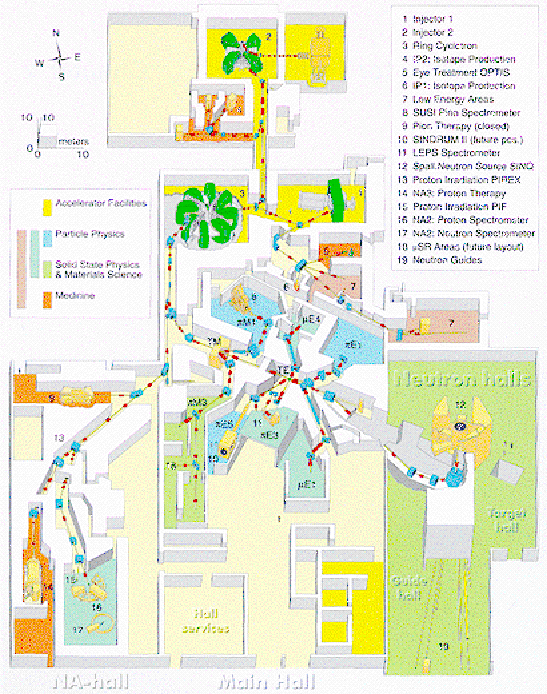





3.1.1 Accelerator components
Figure 3.1 shows an overview of the accelerator facility at PSI. The
accelerator complex at PSI consists of four main parts: the pre-injector, the
Injector II cyclotron, the ring cyclotron, and the Injector I cyclotron. Only
the first three are of interest here. The "Injector I" cyclotron was used from
1974 to 1984 but is now only used when a polarized beam is required and is
therefore unnecessary to the pion beta decay experiment.

Figure 3.1: Overview of the PSI accelerator facility taken from the 1994
user's manual.

Figure 3.2: Schematic of a Cockroft-Walton type DC accelerator like that
used at PSI as a pre-injector. An alternating current with a peak to peak
potential of 2V (where V is some voltage) charges each of the capacitors
(C1,C2,C3,C4,...) such that a large (870 kV) potential is achieved between the
top and bottom of the diode-capacitor ladder.
The pre-injector initially accelerates protons to an energy suitable for
introduction to the "Injector II" The pre-injector is a Cockroft-Walton DC
accelerator which uses an ion source to supply the "Injector II" cyclotron with
870 keV protons. The schematic diagram shown in Figure 3.2 helps to illustrate
the principles of how this accelerator works. An alternating current with a
peak-to-peak potential of 2V is supplied as indicated in the diagram
(where V represents some voltage). On the first half of the cycle, the
first diode is forward biased and capacitor C1 is charged to +2V. On the
second half of the cycle, the bottom of C1 is at +V and the top is at
+3V. The bottom of capacitor C2 is now at -V while the top is at
+3V charging C2 to +4V. This continues up the diode-capacitor
ladder charging all other capacitors to +4V producing a very large,
positive voltage at the top of the last capacitor. This voltage is applied to a
large, hollow conductor in which the ion source resides. The field experienced
by the proton as it emerges from the conductor accelerates it to 870 keV.
Built in the early 1980's at PSI, Injector II accelerates protons from the
pre-injector to a fixed energy of 72 MeV before sending them to the ring
accelerator described below. Injector II is a separated sector cyclotron. It
consists of four large magnets and two RF-cavities. Figure 3.3 shows a
photograph of the Injector II cyclotron. The vacuum pipe which carries the
proton beam from the pre-injector (not shown) to the center of the cyclotron
can be seen in Figure 3.3.
As the protons gain energy, the radius of the orbit increases for the protons
until reaching the extraction point after about 100 revolutions. By using the
injector cyclotron to feed the ring accelerator, much greater extraction
efficiency is achieved. Prior to the construction of the PSI accelerator in the
early 1970's (then called SIN), typical extraction efficiencies were on the
order of 50-70%. This was due to overlapping particle orbits at the outer edge
of the cyclotron where the particles are extracted. By using this method of
stages, greater separation of orbits is achieved at the extraction radius of
the ring accelerator, increasing the extraction efficiency to greater than 90%.

Figure 3.3: Injector II. The 870 keV proton beam enters from the top of the
picture and exits to the right after being accelerated to 72 MeV.
The
ring accelerator at PSI, shown in Figure 3.4, accelerates the protons in the
beam from 72 MeV to 590 MeV. Built at PSI, the ring accelerator was first
commissioned in early 1974. The ring accelerator is an azimuthally varying
field (AVF) cyclotron producing a fixed energy 590 MeV proton beam. The ring
consists of eight magnets pitched at 33 degrees with respect to a radial. The
ring accelerator is capable of producing a 1.5 mA proton beam. Acceleration is
achieved via four RF cavities. The RF cavities operate at a frequency of 50 MHz
and each exposes the protons to a 600 kV field across a 20 cm gap.

Figure 3.4: Ring accelerator. The fields of the eight large magnets keep the
protons orbiting through the cyclotron while the four RF cavities increase the
energy of the protons by a total of 2.4 MeV per rotation.
With an energy gain of 2.4 MeV per revolution, the protons make around 220
revolutions in the ring before extraction. The protons are injected at a radius
of 2.1 m where they experience a magnetic field of 1.5 T. They are extracted at
a radius of 4.5 m where the field is 2.1 T.






















